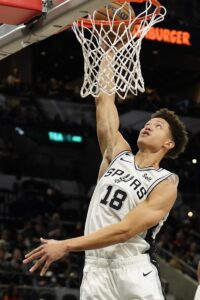The NBA salary cap is somewhat malleable, with various exceptions allowing every team to surpass the $140,588,000 threshold once their cap room is used up. In some cases, teams blow past not only the cap limit, but the luxury tax line of $170,814,000 as well — the Suns, Timberwolves, and Celtics are among the clubs who project to have massive tax bills this season as a result of their spending.
The NBA doesn’t have a “hard cap” by default, which allows clubs like Phoenix, Minnesota, and Boston to build a significant payroll without violating NBA rules. However, there are certain scenarios in which teams can be hard-capped.
The league’s new Collective Bargaining Agreement has carried over the hard cap rules from the 2017 CBA while also expanding them, adding new scenarios in which teams can face hard caps and creating a second salary level that certain teams can’t exceed.
We went into greater detail earlier this month on how teams become hard-capped, but here’s a brief rundown of the ways it can happen in 2024/25:
- A team becomes hard-capped at the first tax apron ($178,132,000) if it makes any of the following moves:
- Acquires a player via sign-and-trade.
- Uses more than the taxpayer portion (up to two years, with a starting salary of $5,168,000) of the mid-level exception to sign a player.
- Uses any portion of the mid-level exception to acquire a player via trade or waiver claim.
- Uses any portion of the bi-annual exception to sign a player or to acquire a player via trade or waiver claim.
- Takes back more than 100% of the salary it sends out in a trade (when over the cap).
- Uses a traded player exception generated during the previous offseason or regular season.
- Signs a player who was waived during the regular season and whose pre-waiver salary was higher than the non-taxpayer mid-level exception ($12,822,000).
- A team becomes hard-capped at the second tax apron ($188,931,000) if it makes any of the following moves:
- Uses any portion of the mid-level exception to sign a player to a contract.
- Aggregates two or more players in a trade for salary-matching purposes.
- Sends out cash in a trade.
- Sends out a player via sign-and-trade and uses that player’s outgoing salary to take back a contract (either in the same transaction or in a subsequent transaction via the resulting trade exception).
Given how many ways there are to create a hard cap, most clubs who don’t intend to operate over one of the two aprons will likely end up hard-capping themselves at one or the other.
Some teams will have to be hyper-aware of that hard cap when they consider any roster move for the rest of the season, but for others it’s just a technicality that won’t affect their plans in any meaningful way.
Listed below are the hard-capped teams for the 2024/25 league year, along with how they created a hard cap.
In some instances, a team made multiple roster moves that would have imposed a hard cap (e.g. acquired a player via sign-and-trade and used the non-taxpayer mid-level exception). Only the first of those transactions is noted below, though in some cases a team made two moves within a single transaction to create a hard cap, in which case each relevant move is mentioned.
Hard-capped at first tax apron
These teams will be prohibited from exceeding $178,132,000 in team salary.
Atlanta Hawks
- Acquired Cody Zeller via sign-and-trade.
- Used a trade exception generated last offseason (for John Collins) to acquire Larry Nance Jr., Dyson Daniels, E.J. Liddell, and Zeller.
Brooklyn Nets
- Acquired Shake Milton via sign-and-trade.
- Used a trade exception generated last offseason (for Patty Mills) to acquire Milton.
- Used a trade exception generated last season (for Spencer Dinwiddie) to acquire Bojan Bogdanovic.
Charlotte Hornets
- Acquired DaQuan Jeffries, Charlie Brown Jr., and Duane Washington via sign-and-trade.
Chicago Bulls
- Used the non-taxpayer mid-level exception to sign Jalen Smith.
Dallas Mavericks
- Used the non-taxpayer mid-level exception to sign Naji Marshall.
Golden State Warriors
- Acquired Buddy Hield and Kyle Anderson via sign-and-trade.
- Took back more than 100% of Klay Thompson‘s outgoing salary in a trade for Hield and Anderson.
Houston Rockets
- Used a trade exception generated last offseason (for Kevin Porter Jr.) to acquire AJ Griffin.
Los Angeles Clippers
- Used the bi-annual exception to sign Nicolas Batum.
Memphis Grizzlies
- Used the non-taxpayer mid-level exception to sign Scotty Pippen Jr.
New Orleans Pelicans
- Took back more than 100% of the aggregated outgoing salaries of Larry Nance Jr., Dyson Daniels, E.J. Liddell, and Cody Zeller in a trade for Dejounte Murray.
Oklahoma City Thunder
- Took back more than 100% of Josh Giddey‘s outgoing salary in a trade for Alex Caruso.
Sacramento Kings
- Acquired DeMar DeRozan via sign-and-trade.
Toronto Raptors
- Took back more than 100% of Jalen McDaniels‘ outgoing salary in a trade for Sasha Vezenkov.
- Used a trade exception generated last season (for Pascal Siakam) to acquire Davion Mitchell.
Washington Wizards
- Took back more than 100% of Deni Avdija‘s outgoing salary in a trade for Malcolm Brogdon.
Hard-capped at second tax apron
These teams will be prohibited from exceeding $188,931,000 in team salary.
Denver Nuggets
- Used the taxpayer mid-level exception to sign Dario Saric.
Indiana Pacers
- Sent out cash in a trade.
New York Knicks
- Aggregated the salaries of Bojan Bogdanovic, Shake Milton, and Mamadi Diakite in a trade for Mikal Bridges.
- Took back salary for a player who was sent out via sign-and-trade (Milton).
No hard cap
- Boston Celtics
- Cleveland Cavaliers
- Detroit Pistons
- Los Angeles Lakers
- Miami Heat
- Milwaukee Bucks
- Minnesota Timberwolves
- Orlando Magic
- Philadelphia 76ers
- Phoenix Suns
- Portland Trail Blazers
- San Antonio Spurs
- Utah Jazz
This list, which figures to continue evolving, will be updated throughout the 2024/25 league year as necessary. It can be found anytime in the “Hoops Rumors Features” menu on the right-hand sidebar of our desktop site, or in the “Features” menu on our mobile site.
 12:25pm: The Grizzlies have agreed to a trade that will send
12:25pm: The Grizzlies have agreed to a trade that will send  July 17: The Magic and free agent point guard
July 17: The Magic and free agent point guard  Bol, who
Bol, who  “We are convinced that Isaiah will have a very big impact on our team this season on and off the court,” said head coach Ty Harrelson. “We were looking for a player with his experience. After meeting him on the sidelines of the NBA Summer League, it was clear that he would fit our idea of the new team.”
“We are convinced that Isaiah will have a very big impact on our team this season on and off the court,” said head coach Ty Harrelson. “We were looking for a player with his experience. After meeting him on the sidelines of the NBA Summer League, it was clear that he would fit our idea of the new team.”